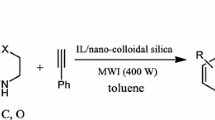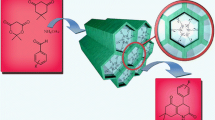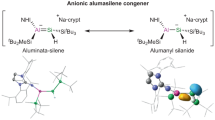Abstract
The zwitterionic λ 5 Si-silicates bis[cis-1,2-diphenylethene-1,2-diolato(2–)](morpholiniomethyl)silicate (2) and bis[cis-1,2-diphenylethene-1,2-diolato(2–)][(2,2,6,6-tetramethylpiperidinio)methyl]silicate (3) were synthesized by various methods, including remarkableSi–C cleavage reactions with benzoin. Treatment of trimethoxy(morpholinomethyl)silane (4), dimethoxy(morpholinomethyl)phenylsilane (5), or dimethoxy(methyl)(morpholinomethyl)silane (6) with two molar equivalents of benzoin in acetonitrile yielded 2. Compound 3 was synthesized by treatment of trimethoxy[(2,2,6,6-tetramethylpiperidino)methyl]silane (7) with two molar equivalents of benzoin in 1,4-dioxane/n-pentane and was isolated as the 1,4-dioxane solvate 3 ·3/2C4H8O2. Compounds 2 and 3 ·3/2C4H8O2 were structurally characterized by solution and solid-state NMR spectroscopy and by single-crystal X-ray diffraction. In addition, the dynamic behavior of 3 in solution was studied by VT 1H NMR experiments.
Similar content being viewed by others
References
Pülm, M. & Tacke, R. 1997 Organometallics 16, 5664-5668.
Review dealing with zwitterionic pentacoordinate silicon compounds: Tacke, R., Pülm, M. & Wagner, B. 1999 Adv. Organomet. Chem. 44, 221-273.
Richter, I., Penka, M. & Tacke, R. 2002 Organometallics 21, 3050-3053.
Selected reviews dealing with higher-coordinate silicon compounds: (a) Tandura, S.N., Voronkov, M.G. & Alekseev, N.V. 1986 Top. Curr. Chem. 131, 99-189; (b) Sheldrick, W.S. 1989 In The Chemistry of Organic Silicon Compounds, Part 1, eds. S. Patai & Z. Rappoport, pp. 227–303. Chichester: Wiley; (c) Bassindale, A.R. & Taylor, P.G. 1989 In The Chemistry of Organic Silicon Compounds, Part 1, eds. S. Patai & Z. Rappoport, pp. 839–892. Chichester: Wiley; (d) Corriu, R.J.P. & Young, J.C. 1989 In The Chemistry of Organic Silicon Compounds, Part 2, eds. S. Patai & Z. Rappoport, pp. 1241–1288. Chichester: Wiley; (e) Holmes, R.R. 1990 Chem. Rev. 90, 17–31; (f) Chuit, C., Corriu, R.J.P., Reye, C. & Young, J.C. 1993 Chem. Rev. 93, 1371–1448; (g) Tacke, R., Becht, J., Lopez-Mras, A. & Sperlich, J. 1993 J. Organomet. Chem. 446, 1–8; (h) Verkade, J.G. 1994 Coord. Chem. Rev. 137, 233–295; (i) Tacke, R. & Dannappel, O. 1996 In Tailor-Made Silicon-Oxygen Compounds–From Molecules to Materials, eds. R. Corriu & P. Jutzi, pp. 75–86. Braunschweig-Wiesbaden: Vieweg; (j) Lukevics, E. & Pudova, O.A. 1996 Chem. Heterocycl. Compd. (Engl. Transl.) 32, 1381–1418; (k) Holmes, R.R. 1996 Chem. Rev. 96, 927–950; (l) Kost, D. & Kalikhman, I. 1998 In The Chemistry of Organic Silicon Compounds, Part 2, Vol. 2, eds. Z. Rappoport & Y. Apeloig, pp. 1339–1445. Chichester: Wiley; (m) Pestunovich, V., Kirpichenko, S. & Voronkov, M. 1998 In The Chemistry of Organic Silicon Compounds, Part 2. Vol. 2, eds. Z. Rappoport & Y. Apeloig, pp. 1447–1537. Chichester: Wiley; (n) Chuit, C., Corriu, R.J.P. & Reye, C. 1999 In Chemistry of Hypervalent Compounds, ed. K. Akiba, pp. 81–146. New York: Wiley-VCH; (o) Brook, M.A. 2000 Silicon in Organic, Organometallic, and Polymer Chemistry, pp. 97–114. New York: Wiley.
Sperlich, J., Becht, J., Mühleisen, M., Wagner, S.A., Mattern, G. & Tacke, R. 1993 Z. Naturforsch. 48b, 1693-1706.
Tacke, R., Becht, J., Dannappel, O., Ahlrichs, R., Schneider, U., Sheldrick, W.S., Hahn, J. & Kiesgen, F. 1996 Organometallics 15, 2060-2077.
(a) Muetterties, E.L. & Guggenberger, L.J. 1974 J. Am. Chem. Soc. 96, 1748-1756; (b) Holmes, R.R. & Deiters, J.A. 1977 J. Am. Chem. Soc. 99, 3318–3326; (c) The degree of distortion was calculated by using the dihedral angle method described in refs. [7a] and [7b]. All nine dihedral angles and the values for the reference geometry of the ideal square pyramid given in ref. [7a] were considered for this calculation.
The hydrogen-bonding systems were analyzed by using the program PLATON: Spek, A.L. 1998 PLATON; University of Utrecht, Utrecht, The Netherlands.
Braun, S., Kalinowski, H.-O. & Berger, S. 1998 150 and more Basic NMR Experiments, pp. 136-139. Weinheim: Wiley-VCH, Germany.
The ammonium proton could be detected in the 1H NMR spectrum at 216 K (δ = 7.00 ppm).
Synthesis of Me(MeO) 2 SiCH 2 Cl: Tacke, R., Sperlich, J., Strohmann, C. & Mattern, G. 1991 Chem. Ber. 124, 1491-1496.
(a) Sheldrick, G.M. 1997 SHELXS-97. University of Göttingen, Göttingen, Germany; (b) Sheldrick, G.M. 1990 Acta Crystallogr., Sect. A 46, 467–473.
Sheldrick, G.M. 1997 SHELXL-97. University of Göttingen, Göttingen, Germany.
Author information
Authors and Affiliations
Rights and permissions
About this article
Cite this article
Dragota, S., Bertermann, R., Burschka, C. et al. Zwitterionic spirocyclic λ5 Si-silicates with two cis-1,2-diphenylethene-1,2-diolato(2–) ligands: Synthesis and structural characterization. Silicon Chemistry 1, 291–297 (2002). https://doi.org/10.1023/B:SILC.0000018381.74490.09
Issue Date:
DOI: https://doi.org/10.1023/B:SILC.0000018381.74490.09




